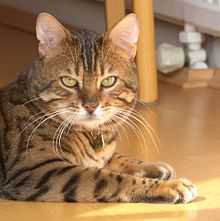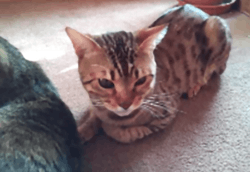Bengal cat
| Bengal | |
|---|---|
 | |
| Bengal cat | |
| Origin | United States |
| Breed standards | |
| TICA | standard |
| FIFe | standard |
| ACF | standard |
| GCCF | standard |
| AACE | standard |
| ACFA/CAA | standard |
| Hybrid cat (Felis catus × Prionailurus bengalensis) | |
The Bengal Cat is a breed of domestic cat developed by selective breeding to evoke the feline denizens of the jungle such as Leopards, Ocelots, Margays and Clouded Leopards. Bengal Cats were developed by the selective breeding of domestic cats with hybrids of domestic cats and an Asian leopard cat (ALC), Prionailurus bengalensis with the goal of creating a confident, healthy and friendly cat with the high contrast and vividly marked coat.[1]
The name "Bengal cat" was derived from the taxonomic name of the Asian leopard cat (P. b. bengalensis). They have a "wild" appearance with large spots, rosettes, and a light/white belly, and a body structure reminiscent of the ALC,[2] but once separated by at least four generations from the original crossing possess a gentle domestic cat temperament.[2]
History
Early History
The earliest mention of an ALC/domestic cross was in 1889, when Harrison Weir wrote in Our Cats and All About Them [3]
However in 1927, Mr Boden-Kloss wrote to the magazine Cat Gossip[4] regarding hybrids between wild and domestic cats in Malaya:
- I have never heard of hybrids between bengalensis (the Leopard Cat) and domestic cats. One of the wild tribes of the Malay Peninsula has domesticated cats, and I have seen the woman suckling bengalensis kittens, but I do not know whether the latter survive and breed with the others!
The earliest mention of a confirmed ALC/domestic cross was in 1934 in a Belgian scientific journal, and in 1941, a Japanese cat publication printed an article about one that was kept as a pet. Jean Mill (née Sugden), the person who was later a great influence of the development of the modern Bengal breed, submitted a term paper for her genetics class at UC Davis on the subject of crossbreeding cats in 1946.[5]
Bengals as a breed
In the 1970s, Dr. William Centerwall bred ALCs with domestic cats to aid his studies in genetics because of their apparent immunity to feline leukemia. Eventually, these hybrids were given to Jean Sudgen Mill because of Centerwall's illness.
At the same time, Bill Engler wanted to preserve the exotic cats' genes by breeding them with house cats. However, none of the today's Bengal lines originate from these cats. He chose the name "bengal," which was accepted by the ACFA.

Jean Mill was instrumental in recognition of Bengals as a breed by TICA in 1983. Her plan was not to keep the breed as a hybrid, but to domesticate these cats by breeding them further with each other.[6]

Greg and Elizabeth Kent were also early breeders, who developed their own line of Bengals using ALCs and Egyptian Maus. This was a very successful line and many modern Bengals will find it in their pedigree.
Although it has become a popular breed, with over 60,000 cats registered with TICA,[7] not all cat registries accept them; in particular, the Cat Fanciers' Association, one of the largest cat registries in the world, does not accept any hybrids.[7]
New developments


- The UK Department for Environment, Food and Rural Affairs, DEFRA, removed the previous licensing requirements for the keeping of Bengal cats in the United Kingdom in 2007.[8]
- The Cheetoh is an attempt to blend two existing domestic breeds of spotted cats with defined characteristics (Bengal and Ocicat), into a third breed.[9] They are only recognized by The International Cat Association.[10]
Long-haired variant
Some long-haired Bengals have occurred since the beginning of the Bengal breeding program,[11] as longer-haired domestic cats were among those used in crosses with the wild Asian leopard cat to produce the breed. Some current F4 and later purebred Bengals carry the recessive long haired genes and when they are mated with each other, they can produce long-haired Bengals. (See Cat coat genetics#Genes involved in fur length and texture.) Such offspring were usually spayed or neutered until ongoing intentional development of the long-hair variety, as they did not then qualify as Bengal breeding stock due to their non-conforming long or semi-long coats. On August 21, 2013, long-haired Bengals were granted "preliminary" breed status in the New Zealand Cat Fancy (NZCF) registry under the breed name Cashmere, at the behest of a breeder named Damian Vaughan.[12][13] They are currently not recognized by any other cat registries.
Description
Appearance

Bengal cats have "wild-looking" markings, such as large spots, rosettes, and a light/white belly, and a body structure reminiscent of the leopard cat.[2] A Bengal's rosetted spots occur only on the back and sides, with stripes elsewhere. The breed typically also features "mascara" (horizontal striping alongside the eyes), and foreleg striping.
The Bengal cat is usually either classed as brown-spotted or snow-spotted (although there are more colours, brown and snow are the only colours of Bengal that the Governing Council of the Cat Fancy (UK) recognize). Within brown Bengals, there are either marble or spotted markings. Included in the spotted variation is rosetted, which consists of a spot with a dark line surrounding it. Snow Bengals are also either marble or spotted, but are also divided into blue-eyed or any other colour eyes.
The International Cat Association recognizes several Bengal colours (brown, seal lynx point, mink, sepia, silver) and patterns (spotted and marbled) for competition and shows. In the New Traits class, other colours may be shown, as well as longhairs.[14]
Temperament
After three generations from the original crossing, the breed usually acquires a gentle domestic cat temperament;[2] however, for the typical pet owner, a Bengal cat kept as a pet should be at least four generations (F4) removed from the leopard cat. The so-called "foundation cats" from the first three filial generations of breeding (F1–F3) are usually reserved for breeding purposes or the specialty pet home environment.[15]
Health
Since the late 1960s—when the Bengal cat was developed through hybridization of Asian Leopard cats and domestic cats—it has gained huge popularity. However, in recent years, a novel early-onset autosomal recessive disorder was described in this breed. This disease appears to be an early-onset primary photoreceptor disorder, leading to blindness within the first year of age.[16]
The prevalence of Hypertrophic Cardiomyopathy (HCM) is 16.7% (95% CI = 13.2–46.5%).[17]
References
- ↑ http://www.tica.org/public/breeds/bg/intro.php
- ↑ 2.0 2.1 2.2 2.3 Bengal Cat Animal World, Information Resource: Exotic Pets & Animals. Retrieved on: January 18, 2008
- ↑ Harrison William Weir, Our Cats and All About Them: Their Varieties, Habits, and Management, (Houghton, Mifflin & Co., 1889), p. 55.
- ↑ Cat Gossip, Periodical.
- ↑ "A Brief History of the (Bengal) Universe". Bengal Classifieds. Retrieved 2009-10-25.
- ↑ "HISTORY OF THE BENGAL CAT".
- ↑ 7.0 7.1 Peters, Sharon L. (June 28, 2007). "Bengal cats leap into owners' hearts". USA Today. Retrieved 2009-10-25.
- ↑ Defra, UK - Wildlife & Countryside
- ↑ Domestication by Clive Roots, p. 114, Greenwood Publishing Group, 2007. Books.google.com. Retrieved 2013-09-12.
- ↑ "The TICA's Standing Rules, page 55 (p. 59 of the PDF) reads "701.4.5 The following is a list of the names and current abbreviations for experimental breeds as of 05/01/12: ... XCT- ExperimentalCheetoh"" (PDF). Retrieved 2013-09-12.
- ↑ Potter, Cathy (2006). ""Cashmere"—The Longhair Bengal". Grand Rapids, Michigan: AuroraLights Bengals. Archived from the original on 2013-09-27. Retrieved 2013-09-17.
We (Longhair breeders as a group) decided on the name 'Cashmere' due to the fact that the Longhairs have such an amazingly soft and silky coat. The Longhairs were not developed intentionally, but instead have occurred since the beginning of the Bengal breeding programs.
- ↑ "Minutes of Executive Council Meeting, August 2013". New Zealand Cat Fancy. Retrieved 22 December 2013.
- ↑ "Agenda for Executive Council Meeting, August 2013" (PDF). New Zealand Cat Fancy. Retrieved 22 December 2013.
- ↑ Alan Brown. "Bengal cats & kittens - The International Bengal Cat Society - TIBCS - exotic looks with spots, marbling and snow". Bengalcat.com. Retrieved 2013-09-12.
- ↑ "Breeding the ALC with domestic cats". Bengalcat.co.uk. Retrieved 2013-09-12.
- ↑ Narfström, K., Menotti-Raymond, M., Seeliger, M. (2011) Characterization of feline hereditary retinal dystrophies using clinical, functional, structural and molecular genetic studies. Veterinary Ophthalmology (2011) 14, Supplement 1: 30–36.
- ↑ "Myosin-Binding Protein C DNA Variants in Domestic Cats (A31P, A74T, R820W) and their Association with Hypertrophic Cardiomyopathy - Longeri - 2013 - Journal of Veterinary Internal Medicine - Wiley Online Library". Onlinelibrary.wiley.com. 2013-01-17. Retrieved 2013-11-02.
External links
| Wikimedia Commons has media related to Bengal cat. |
| Look up Bengal in Wiktionary, the free dictionary. |
| ||||||||||||||||||||||||||||||||||||||||||||||